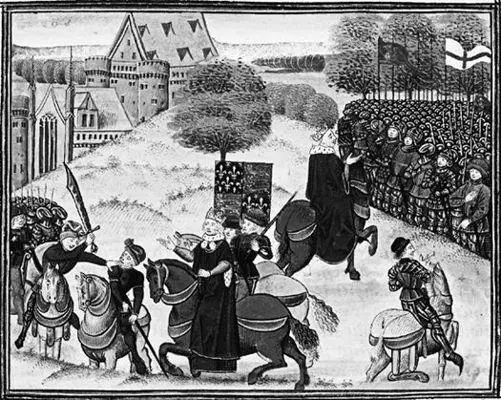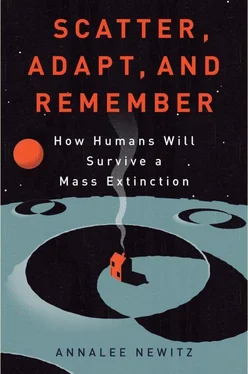
An image from the British Library (circa 1385–1400), depicting the Mayor of London executing Wat Tyler, leader of the Peasants’ Revolt, while King Richard II looks on. (illustration credit ill.7)
The magnitude of the plague also called into question every form of authority in the medieval world. Though the Church called the pestilence a punishment from God, it was hard to avoid noticing that so-called godly men and women were meeting the same fate as the godless—nor did their prayers prevent the plague. Indeed, Chaucer was highly critical of Church officials in The Canterbury Tales, a sentiment he voiced because it reflected popular, though controversial, ideas in his day. Likewise, the common people began questioning government authorities in the wake of the Black Death, especially once serfs had a better bargaining position.
Still, those authorities did their best to cling to the old rules. In the wake of the Black Death, the British government reacted to the labor shortage by trying to limit wages by law. In 1351, just four years after the first plague year, the English Statute of Laborers stipulated that all wages should be held at the pre-pestilence levels of 1340. The situation quickly became untenable. Angry peasants demanding better wages stormed Chaucer’s neighborhood, burning homes and dragging rich people from their rooms to be killed. It’s not clear whether Chaucer was actually at home when the riots happened, but some of his friends and business associates were murdered during the mob violence. Soon after, the government repealed the statute, along with similar laws, allowing peasants to earn higher wages and achieve some autonomy from their landlords. Within days of the Peasants’ Revolt, Chaucer gave up his cozy rooms in Aldgate and moved permanently to Kent, near Canterbury, beginning a new career as an estate manager and city planner. The city where he’d grown up had transformed so radically that he no longer felt welcome there.
Similar rebellions racked France and Italy, as the surviving laborers realized how valuable they were in a depopulated Europe. Though bloody at first, this kind of rebellion led to better treatment of workers and eventually to the rise of the middle classes. The benefits of these social reforms extended even to women, a group who had almost never been part of the traditional labor force. After the Black Death, there was a rise in the number of women running their own taverns. (We see the evidence in records of who was purchasing grain for brewing beer, where there is a notable uptick in female buyers.)
The first wave of plague also led directly to some of the first city-planning efforts aimed at improving the lives of the general populace. In the wake of the pandemic, many cities established boards of public health, which by the fifteenth century were responsible for sanitation and waste disposal in cities like Florence and Milan. These boards also engaged in what today we’d call “health surveillance,” compiling weekly lists of people who died from epidemic diseases so that officials could spot a pandemic before it became widespread. Just as we do today, city officials in early Renaissance Florence would establish quarantines for people afflicted by disease, to prevent a major outbreak.
“The Poor That Cannot Be Taken Notice Of”
The scale of the fatalities from the Black Death during the 1300s was caused by the structure of the societies where it spread. Close living conditions made a deadly disease into an apocalyptic pandemic. SUNY Albany anthropologist Sharon DeWitte worked with a group of biologists who sequenced bacterial DNA from medieval victims of the epidemic. They discovered ample evidence that bubonic plague was caused by the bacterium Yersinia pestis, which is almost always spread by contact, not air. Urban societies, with their closely packed populations, were therefore ideal breeding grounds for Y. pestis. The other major cause of the near-extinction events during Chaucer’s childhood was lack of food. In 1348, the Black Death came soon after a terrible famine had weakened the immune systems of people, mostly the poor, who had the least to eat. An epidemic became a “Black Death” in part because of how the ruling class allocated economic resources.
The plagues of the late fourteenth century called attention to one of the greatest threats to human adaptability in an urbanizing world. Put in the simplest possible terms, that threat is a stark class division between rich and poor. When many people live in close proximity, but a large portion of them are trapped in deprived, unhealthy conditions, the entire society is put at risk of extinction. Pandemics spread rapidly among the vulnerable, bringing death to everyone. But this isn’t just a matter of epidemiology. Feudalism was an economic system which kept a major part of the population locked into poverty, and it was so rigid that any perturbation of the social order left it open to disruption. The pestilence that Chaucer described coming “everemoore” attacked a society whose rules made it both biologically and culturally vulnerable.
And yet the humans who survived one of the greatest disease apocalypses in our history did not respond with despair and a descent into savagery. There was no zombie freakout scenario, as we like to imagine today. Instead, the Peasants’ Revolt led to social reforms that improved the lot of the poor in the decades that followed. Our facility for cultural adaptation can bloom even in the wake of seeming apocalypse. Though it would be centuries before the renewed interest in science that arose with the Age of Enlightenment, let alone the germ theory of disease, the humans who survived the plague managed to lay the foundations for political structures in which every class could advocate for its own best interests. At the same time, newly created health boards stood a chance of protecting vulnerable populations, too.
As European cities grew and feudalism crumbled, the rise of the market economy forged new connections between urban societies through international trade. Humans once again raced to adapt to the dangers created by a global civilization with a massive, vulnerable population.
Though epidemics seemed to hit roughly once a generation in England, the plague summer of 1665 killed so many people that it was called simply the Great Plague. It was also a period of rapid cultural change, when class divisions again took on deadly proportions. In the diaries of a young, well-connected naval official named Samuel Pepys (pronounced peeps ), we have a record of daily life during this time.
In late August of 1665, Pepys described the streets of London in his diary:
But now, how few people I see, and those walking like people that have taken leave of the world…. Thus this month ends, with great sadness upon the public through the greatness of the plague, everywhere through the Kingdom almost. Every day sadder and sadder news of its increase. In the City died this week 7496; and all of them, 6102 of the plague. But it is feared that the true number of the dead this week is near 10000—partly from the poor that cannot be taken notice of through the greatness of the number, and partly from the Quakers and others that will not have any bell ring for them. As to myself, I am very well; only, in fear of the plague.
Pepys’s horror grows as the death tolls rise, even as he must continue going about his business—which, by the way, was booming in the plague year. As his neighbors fall prey to the disease, he sees “Searchers,” groups mostly of women, who inspect houses looking for evidence of the Black Death. Where they find it, the Searchers impose quarantine on the people living there, and mark the doors with red crosses. In the passage I’ve excerpted from above, Pepys describes empty streets where a few brave people outside like himself walk around in a daze. He’s wandering through an apocalyptic urban landscape, recognizable to anyone who has watched movies like 28 Days Later or seen the TV series The Walking Dead .
Читать дальше







![Аннали Ньюиц - Автономность [litres]](/books/424681/annali-nyuic-avtonomnost-litres-thumb.webp)





